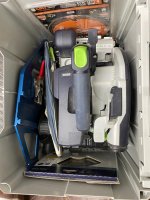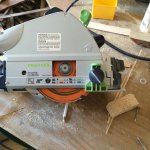Hi everyone, quick question on diamond abrasive blades. I'm just a homeowner trying to cut some siding/trim for repairs and retrofits. I don't need the longest lasting blade or some incremental improvement in cut quality, within reason.
It looks like my options are a CMT blade ($100), a Diablo ($50), or the official Festool blade. The CMT and Diablo both are 1.8mm thick, but Festool applications had told me my older TS 55 REQ-F-Plus-FS takes 2.2mm blades. So am I stuck with the $150 Festool 202958?
Assuming the third party blades won't jeopardize the reliability of the saw, I'm inclined to save money since this blade will only be used a handful of times.
https://www.toolpros.com/cmt-236-160-04h-fiber-cement-blade-160mm-x-4-teeth-for-ts-55-hk-55.htmlhttps://www.diablotools.com/products/D0604TSH
It looks like my options are a CMT blade ($100), a Diablo ($50), or the official Festool blade. The CMT and Diablo both are 1.8mm thick, but Festool applications had told me my older TS 55 REQ-F-Plus-FS takes 2.2mm blades. So am I stuck with the $150 Festool 202958?
Assuming the third party blades won't jeopardize the reliability of the saw, I'm inclined to save money since this blade will only be used a handful of times.
https://www.toolpros.com/cmt-236-160-04h-fiber-cement-blade-160mm-x-4-teeth-for-ts-55-hk-55.htmlhttps://www.diablotools.com/products/D0604TSH



